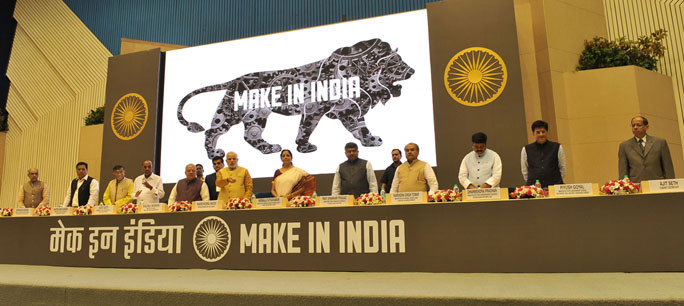Make in India is an initiative of the Government of India to encourage multinational, as well as domestic companies to manufacture their products in India. It was launched by Prime Minister Narendra Modi on 25 September 2014. India would emerge, after initiation of the program, as the top destination globally for foreign direct investment, surpassing China as well as the United States.
With this initiative, Mr. Modi is literally inviting the rich and semi-rich countries to step in India and invest their money for the future of India. It’s like inviting the countries to set up their companies in India and manufactured in the territory of our country.
Sell everywhere but manufacture in India
sums it up all.
Many foreign companies making the investments in Make in India project thus having a great impact on the economy of India. Obviously, if the big companies will set up their branches here, it will directly affect the GDP of India. So if you are planning to start your business in India by making an investment in Make in India then first read these effects of Make in India over the economy:
Supreme Objective
The supreme objectives of Make in India are as follow:
Manufacturing Sector
- One online portal for the process of industrial license applications.
- Earlier, the validity of the industrial license was of two years, now it has been increased to three years.
Infrastructure
- Constructing industrial infrastructure and smart cities
- Intensifying skill development
- Safeguarding intellectual development
Worthy and Superior Industrial Sectors
- Endorsing innovation
- To accelerate investment
- 100% FDI in defense, railways, and construction
Main Focus of Make in India
The main focus of Make in India Campaign is mainly in 25 sectors. Almost every sector is capital-intensive and demands a lot of skill. So, with the more and more investment in these sectors, the main focus will be on increasing employment and the use of advanced technology. These sectors are
- Automobiles
- Food processing
- Renewable energy
- Automobile components
- IT and BPM
- Roads and highways
- Aviation
- Leather
- Space
- Biotechnology
- Media and entertainment
- Textiles and garments
- Chemicals
- Mining
- Thermal power
- Construction
- Oil and gas
- Tourism and hospitality
- Defence manufacturing
- Pharmaceuticals
- Wellness
- Electrical machinery
- Ports
- Electronic system
- Railways
Make in India Impact on the Economy
Recently, the country has been hit by the recession and it is still struggling to come out of it. The citizens of India have had enough so they decided to turn the government upside down and change it altogether. With the change in the government, a drastic change in the ways in which the system works could be seen.
Today, everyone is well aware of the Make in India initiative and the motives that this initiative holds. On the other hand, the impact of this campaign is no secret, either. This is going to make India, one of the leading nations in the entire world if followed dutifully.
Related- GST: A complete Insight
Make in India Contribution on Gross Domestic Product (GDP)
Sectors | Contribution (Before Make in India) | Expected Contribution (After Make in India) |
| Automobiles | $8 Billion | 50 Billion |
| Food Processing | $1.43 Trillion | $7.21 Trillion |
| Renewable Energy | $20 Billion | $40 Billion |
| Automobile Components | $10.81 Billion | $39 Billion |
| IT and BPM | $143 Billion | $300 Billion |
| Roads and Highways | $14 Billion | $57.8 Billion |
| Aviation | $17 Billion | $25 Billion |
| Leather | $28 Billion | $76 Billion |
| Space | $47 Billion | $85 Billion |
| Biotechnology | $1.1 Billion | $7 Billion |
| Textiles and Garments | $67 Billion | $100 Billion |
| Chemicals | $16.8 Billion | $70 Billion |
| Mining | $56 Billion | $80 Billion |
| Thermal Power | $34 Billion | 50 Billion |
| Construction | $78.5 Billion | $140 Billion |
| Tourism and Hospitality | $20.236 Billion | $21.071 Billion |
| Defense Manufacturing | $56 Billion | $100 Billion |
| Pharmaceuticals and Wellness | $500 Billion | $1 Trillion |
| Electrical Machinery | $54.3 Billion | $65 Billion |
| Ports | $68.3 Billion | $86 Billion |
| Electronic System | $43 Billion | $94.2 Billion |
| Railways | $80 Billion | $100 Billion |
Just between September 2014 and November 2015, the government had received proposals from the interest companies for manufacturing electronics in India worth Rs. 1.20 Lakh Crore. Moreover, 24.8% of smartphones that were shipped in April-June of 2015 were manufactured in India. This initiative has the tendency to turn the Indian economy upside down, all for the better reasons. With the investment in the manufacturing sector, advancement in the technology, generation of the employment opportunities, and the ways to make the labor skilled, our country will be touching the sky of success in just a matter of few years. Moreover, the way Modi government has been working is commendable and it justifies the need of transformation in the country.
However, like every coin has two sides, we cannot ignore the negative impact and the probabilities of failure of this campaign. There are some constraints and limitations of make in India campaign as well.
The main thing is that the focus is on the manufacturing sector, and the population of India is majorly middle-class or lower middle-class. So, the products manufactured by the foreign companies will be entirely for the upper section of the society. Hence, it is possible that the goals and aspirations of Make in India may not find much success.
However, as that quote goes ‘Never judge a book by its cover.’ So, today, we are not going to judge the Make in India initiative by its policies and schemes, but future results. We will hope for the success of this initiative.
Conclusion of Make in India
In the end, when you talk about all the impacts that the Make in India has on the economy, the only thing that the citizens are concerned about is the country’s GDP. After all, that is the only thing that defines the accurate situation of the country. The better the GDP, the more developed will be the nation.
And, in this case, the campaign of Mr. Narendra Modi is concentrating more on the manufacture, so it is natural that it will have a better impact on the GDP. Currently, the GDP is $1.877 trillion (6%), and it is increasing at the annual rate of 5%. And, the intentions are to make India stand at the 3rd position by 2020 in terms of Gross Domestic Product.






thanks
itz really good